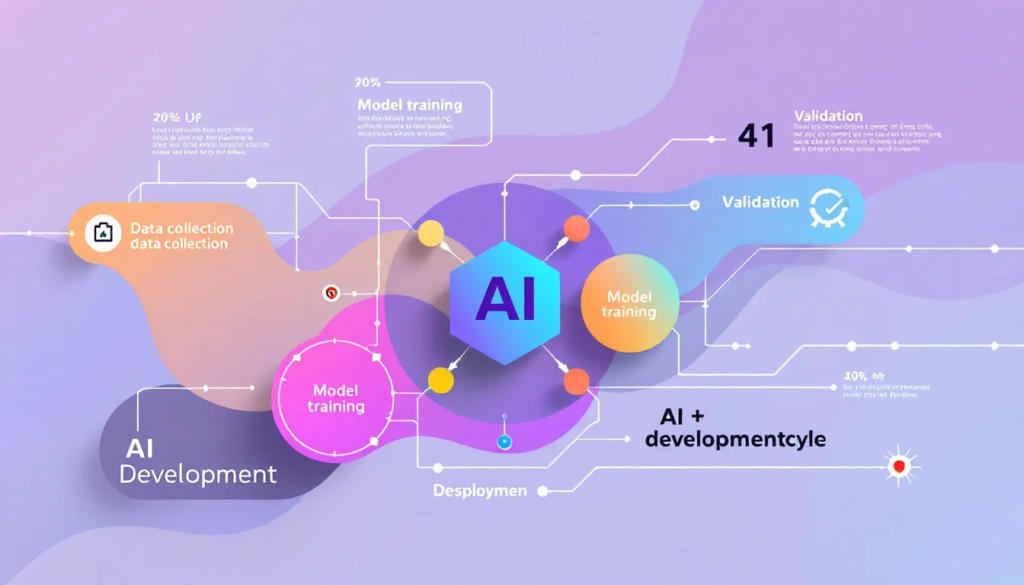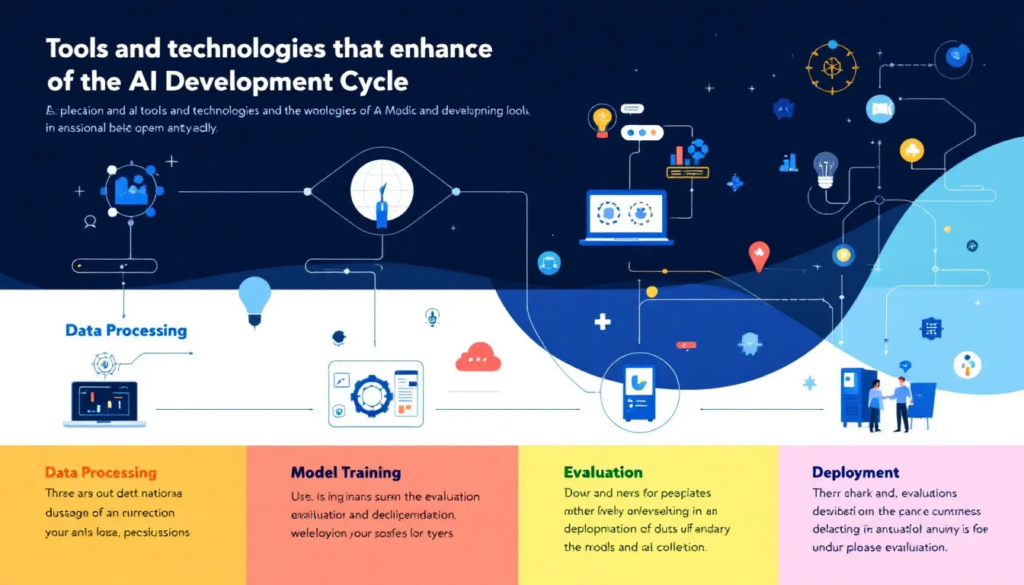Looking to master the AI development cycle? This article breaks down the essential steps you need to build successful AI solutions—from defining the problem and gathering data to deploying models and continuous monitoring. Understanding each phase of the AI development cycle is key to creating effective and adaptable AI systems.
Key Takeaways
– The AI development cycle consists of structured phases, including problem identification, data collection, model training, evaluation, deployment, and continuous monitoring, ensuring efficient and effective AI solutions.
– Key challenges in the AI development cycle include data quality, technical expertise, and maintenance, which require strategic planning and robust resources to ensure successful implementation.
– Ethical considerations, including data privacy, fairness, and bias mitigation, are essential in AI development processes to foster trust and align with societal values.
Defining the AI Development Cycle

The ai life cycle is a structured approach to developing and deploying AI solutions through well-defined phases. This ai lifecycle encompasses everything from problem identification to model deployment, ensuring each step is meticulously planned and executed. The sequential progression of tasks and decisions drives effective AI development and deployment, making it essential to understand each phase’s nuances.
Following a structured development life cycle ensures that AI solutions are implemented efficiently and effectively, allowing for scalable AI solutions that can adapt to evolving requirements. This iterative process not only enhances the model’s performance but also aligns the AI development process with broader business objectives.
Problem Identification and Requirements Gathering
The first step in the AI development cycle involves defining the problem that the AI solution will address. This phase is critical as it establishes the project’s direction and lays the foundation for the entire AI project. Clearly identifying the business problem and understanding the end-users and beneficiaries allows developers to tailor the AI solution to meet specific needs.
During the requirements gathering stage, essential questions must be addressed: What do you want the AI to achieve? Who will use it, and how? Answering these questions ensures that the development process aligns with real-world scenarios and user interactions, ultimately leading to a more effective and relevant AI solution
Data Collection and Preparation
Data collection is the backbone of any AI project, providing the raw material needed for training AI models. The data acquisition phase involves gathering relevant data from various sources, ensuring it is comprehensive and suitable for the problem at hand. To collect data, collecting relevant data is crucial as it forms the foundation for any AI solution.
Once data is collected, the data preparation phase begins. This involves cleaning the data by removing errors, handling missing values, and transforming it into a format suitable for analysis. Proper data preparation is essential to maximize the potential of the dataset and ensure the AI models learn effectively from high-quality data.
Irrelevant or inadequate data can significantly limit the effectiveness of the AI system. Therefore, it’s vital to invest time in the data generation and preparation process to avoid poor-quality outcomes. This time-consuming phase is foundational for creating robust generative ai models that can make informed decisions based on accurate and well-prepared data.
Model Selection and Training
Selecting the right machine learning algorithms and techniques is critical for developing an AI model that effectively addresses the specific business problem. Popular machine learning frameworks, such as TensorFlow and PyTorch, provide pre-built algorithms and functions that accelerate the model development process, enabling rapid building and evaluation.
Model training involves multiple iterations, where the AI model refines itself based on performance feedback to achieve a satisfactory level of accuracy. Techniques like feature engineering, which creates effective input variables, along with fine-tuning the model and optimizing hyperparameters, can significantly enhance model performance.
During the training phase, using a combination of pre trained model and customized training with specific datasets can improve the model’s accuracy and ability to generalize across different scenarios. This iterative development process ensures that the AI model achieves optimal performance before moving to the next stage.
Model Evaluation and Validation
Model evaluation is a critical step to ensure that the AI model meets the required performance standards before deployment. Common metrics used to evaluate AI model performance include:
– Accuracy
– Precision
– Recall Validation is typically conducted on a separate dataset to provide an unbiased assessment of the model’s ability to generalize to new data.
If the AI model’s performance does not meet the requirements, it is sent back for further training or tweaking. This may involve adjusting model’s parameters, fine-tuning the model, or even gathering additional data to improve its performance. Limited evaluations can mask potential societal harms, making it essential to address issues like model calibration differences, generalizability across populations, and the model’s ability.
By using rigorous evaluation metrics and performance monitoring, developers can ensure that the deployed models perform as expected and deliver the intended business value. This iterative process of evaluation and validation is crucial for the success of any AI project.
Deployment and Integration
Model deployment is a crucial phase where the trained model is put into production to address real-world problems. Despite its importance, this phase is often understudied, with limited published information on successful strategies. The deployment process involves either integrating the AI model into existing systems or developing new platforms, which can be based on cloud, on-premises, or edge solutions.
Successful deployment often necessitates the integration of the AI model into existing systems to effectively address practical challenges. Technical compatibility issues can arise during this phase, potentially hindering the deployment process. Therefore, careful planning and consideration of the production environment are essential for the successful implementation of AI models.
Continuous Monitoring and Maintenance
Continuous monitoring post-deployment is essential to detect performance or data quality issues, ensuring adaptability and longevity in dynamic applications. To maintain performance, it’s necessary to monitor performance metrics, update algorithms, and retrain models with new data through model monitoring as an ongoing process.
If the model’s performance is not as expected, updating the model with new data or refining it based on user feedback is crucial. Ongoing maintenance of AI projects is essential over time to address resource-intensive challenges associated with monitoring and retraining, ensuring the AI solution continues to deliver value.
Key Challenges in the AI Development Cycle

The complexity and demanding nature of the AI model development process often present significant challenges. Implementing an agile framework can help make the AI project lifecycle more adaptable and responsive to changes, ensuring that the development process remains efficient and effective.
Compliance with data privacy regulations is becoming increasingly important as AI technologies are deployed. These regulations can add another layer of complexity to the AI development lifecycle, requiring careful consideration and planning to ensure compliance and mitigate risks.
Data Quality and Bias
The quality of data directly influences the accuracy and efficiency of AI systems. Effective data management tools are crucial for maintaining data integrity during large-scale AI projects. Key factors affecting data quality include:
– Completeness
– Depth
– Relevance
– Any legal or regulatory restrictions.
Bias in AI systems often stems from the data quality and the societal contexts from which the data is derived. Addressing biases involves understanding their origins, which can stem from data or human choices.
Strategies such as implementing synthetic data generation and ensuring diversity in training data can help reduce biases and improve the overall fairness of AI models.
Technical Expertise and Resources
Having skilled technical expertise is critical as it drives the successful implementation of AI solutions. However, a shortage of skilled AI professionals is a major obstacle for organizations aiming to implement AI solutions. This shortage can limit the capacity to develop and deploy effective AI models.
Inadequate computational resources can significantly limit the capacity to train and deploy complex AI models. Success in AI development hinges on a combination of skilled professionals and robust computational resources, making it essential for organizations to invest in both areas.
Maintenance and Scalability
Maintaining data governance is essential to prevent outdated or biased information from influencing AI outcomes. Adapting AI systems to new data and requirements can be resource-intensive, demanding ongoing updates and adjustments. This can be a significant challenge for organizations looking to scale their AI solutions.
The scalability of AI solutions may be hampered by insufficient infrastructure and operational limits. Therefore, it’s crucial to ensure that the infrastructure is capable of supporting the deployment phase and continuous monitoring, allowing for scalable AI solutions that can grow with the organization’s needs.
Tools and Technologies Enhancing the AI Development Cycle

AI development relies on a range of tools to streamline processes and enhance efficiency. These tools enable automation and efficiency in the software development process, making it easier to manage the complexities of AI projects. A variety of specialized tools exist that cater to different stages of the AI development lifecycle.
Utilizing these tools can significantly enhance the development process, ensuring that AI solutions are developed and deployed efficiently. By leveraging the right tools, organizations can improve model performance, manage data effectively, and streamline the overall AI development process.
Data Processing and Management Tools
AI and machine learning technologies streamline data management tasks like data discovery and cleansing. Effective data management can help eliminate data silos, improving access and usability of data across organizations. Effective handling of large datasets in AI projects relies on utilizing data management tools.
These tools facilitate the data acquisition phase by enabling efficient data collection, preparation, and data labeling. By ensuring data quality and governance, these tools help create robust data pipelines that support the development of high-performing version control systems machine learning models.
Machine Learning Frameworks
Popular machine learning frameworks like TensorFlow and PyTorch provide essential libraries for model building. These frameworks offer a structured environment for building and training AI models, making them indispensable tools in the AI development process.
These frameworks offer a variety of features such as built-in functions for data handling, model training, and optimization. Leveraging these frameworks significantly streamlines the AI development process, enhances collaboration, and increases efficiency in model training.
Cloud Platforms and Infrastructure
Cloud platforms enable scalable resources that support the computational demands of AI model training and deployment. These platforms offer the necessary infrastructure for scalable deployment of AI models, reducing the need for extensive on-premises resources.
Cloud services offer flexible environments for building and deploying AI solutions, making them a crucial component of the AI development cycle. By leveraging cloud platforms, organizations can efficiently manage data sources, data pipelines, and deployment phases, ensuring the scalability of AI solutions.
Ethical Considerations in AI Development
Ethical AI practices are increasingly vital as AI systems make significant decisions affecting people’s lives. Engaging with ethical challenges in AI is essential to ensure responsible development and deployment, aligning the AI development process with societal values.
Ethical considerations in AI development ensure that various decisions throughout the lifecycle align with societal values. By promoting transparency and integrating ethical implications throughout the AI development lifecycle, developers can build trust in their technology and ensure it is used responsibly.
Data Privacy and Security
Strong data protection measures are vital to safeguard personal information from misuse. AI privacy involves safeguarding personal information collected and used by AI systems, impacting public trust. Strong security measures during data collection are essential to prevent unauthorized access.
Strong data protection, a focus on privacy, and effective security measures establish a foundation for trust in AI systems. Ensuring data governance and implementing robust security protocols can mitigate risks and enhance the ethical use of AI technologies.
Fairness and Bias Mitigation
Data used in AI can carry inherent biases, resulting from both training data and user interaction. Regular evaluation of AI systems is crucial to detect and address unintended biases that may arise during development.
Addressing fairness in AI involves implementing strategies to mitigate bias, such as using diverse training data and continuously monitoring AI models for bias. By focusing on fairness and bias mitigation, developers can ensure that AI systems provide equitable outcomes and adhere to ethical standards.
Summary
In summary, mastering the AI development cycle involves navigating through well-defined phases, from problem identification to continuous monitoring. Each phase is critical in ensuring that AI solutions are developed, deployed, and maintained effectively. Understanding and addressing key challenges, such as data quality, technical expertise, and scalability, is essential for successful AI implementation.
By leveraging advanced tools and technologies, maintaining ethical standards, and focusing on continuous improvement, organizations can harness the full potential of AI. The journey through the AI development cycle is complex, but with a structured approach and a commitment to best practices, it is possible to develop scalable AI solutions that drive significant business value and societal impact.

Leave a Reply